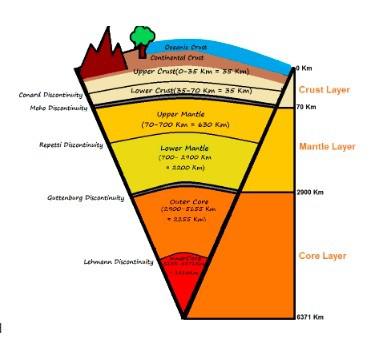Mains Daily Question
Dec. 12, 2023
Q2. What do you mean by seismic discontinuities? With the help of a diagram, discuss the various discontinuities in the earth. (10 marks, 150 words)
|
Approach for the answer: Understanding the question: The question is asking about the meaning of seismic discontinuities, and we have to mention the various discontinuities of the earth as we go down along the radius towards the core from the surface of the earth. Introduction: Start the answer by introducing the earth’s interior and how these discontinuities can tell us about the earth’s geology. Body: The question has two main demands:
Conclusion: Conclude your answer with the relevance of studying seismic discontinuities and what role advancing technologies can play in it. |
Answer: The Earth's interior is a complex and dynamic system that holds many mysteries waiting to be unraveled. By studying these seismic discontinuities, scientists gain valuable insights into the different layers of the Earth and the processes shaping our planet's geology.
|
Seismic discontinuities: |
Seismic discontinuities are regions in the earth where seismic waves behave a lot differently compared to the surrounding regions due to a marked change in physical or chemical properties. When seismic waves pass between geologic layers with contrasting seismic velocities, reflections, refraction (bending), and the production of new wave phases often result in seismic discontinuities.
|
Various discontinuities in the Earth: |
- Conrad Discontinuity: It is a transition zone between SIAL (Silica and aluminum) and SIMA (silica, iron, and magnesium). It is the discontinuity between upper and lower crust. In passing through the Conrad discontinuity, the velocity of longitudinal seismic waves increases abruptly.
- Mohorovich Discontinuity: The discontinuity between the crust and mantle is called the Mohorovich or Moho Discontinuity. The Moho lies at a depth of 35 km beneath the continents and 8 km beneath the oceanic crust. The Moho separates both the continental crust and the oceanic crust from the underlying mantle. The Moho lies almost entirely within the lithosphere, only beneath the Mid Oceanic Ridge does it define the lithosphere and asthenosphere boundary.
- Repetti Discontinuity: The discontinuity between the upper mantle and the lower mantle is known as Repetti Discontinuity.
- Guttenberg’s Discontinuity: The discontinuity is between the lower mantle and the outer core. The core is separated from the mantle by Guttenberg’s Discontinuity. In this zone, the velocity of seismic waves changes suddenly. The velocity of the P wave decreases, and the S wave completely disappears at this depth. S wave shear material cannot transmit through the liquid. So, it is believed that the part above the discontinuity is solid and the part beneath the discontinuity is liquid or in molten form.
- Lehmann Discontinuity: The discontinuity between the upper core and the lower core is called Lehmann Discontinuity.
The study of seismic discontinuities continues to be an essential area of research, advancing our knowledge of the Earth's geology and contributing to various fields of earth sciences. As technology and research methods continue to evolve, our understanding of seismic discontinuities will further deepen, paving the way for exciting discoveries about the planet.


